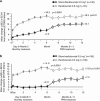Management of retinal vascular diseases: a patient-centric approach
- PMID: 22495396
- PMCID: PMC3335302
- DOI: 10.1038/eye.2012.32
Management of retinal vascular diseases: a patient-centric approach
Abstract
Retinal vascular diseases are a leading cause of blindness in the Western world. Advancement in the clinical management of these diseases has been fast-paced, with new treatments becoming available as well as license extensions of existing treatments. Vascular endothelial growth factor (VEGF) has been implicated in certain retinal vascular diseases, including wet age-related macular degeneration (AMD), diabetic macular oedema (DMO), and retinal vein occlusion (RVO). Treatment of wet AMD and visual impairment due to either DMO or macular oedema secondary to RVO with an anti-VEGF on an as needed basis, rather than a fixed schedule, allows an individualised treatment approach; providing treatment when patients are most likely to benefit from it, while minimising the number of unnecessary intravitreal injections. Thus, an individualised treatment regimen reduces the chances of over-treatment and under-treatment, optimising both the risk/benefit profile of the treatment and the efficient use of NHS resource. Streamlining of treatment for patients with wet AMD and visual impairment due to either DMO or macular oedema secondary to RVO, by using one treatment with similar posology across all three diseases, may help to minimise burden of clinic capacity and complexity and hence optimise patient outcomes. Informed treatment decisions and efficient clinic throughput are important for optimal patient outcomes in the fast-changing field of retinal vascular diseases.
Figures





Comment in
-
More on a patient-centric approach in the anti-VEGF therapy.Eye (Lond). 2012 Oct;26(10):1388. doi: 10.1038/eye.2012.148. Epub 2012 Jul 20. Eye (Lond). 2012. PMID: 22814805 Free PMC article. No abstract available.
References
-
- Bunce C, Xing W, Wormald R. Causes of blind and partial sight certifications in England and Wales: April 2007–March 2008. Eye (Lond) 2010;24 (11:1692–1699. - PubMed
-
- Bunce C, Wormald R. Causes of blind certifications in England and Wales: April 1999–March 2000. Eye (Lond) 2008;22 (7:905–911. - PubMed
-
- Ferrara N, Gerber HP, LeCouter J. The biology of VEGF and its receptors. Nat Med. 2003;9 (6:669–676. - PubMed
-
- Lopez PF, Sippy BD, Lambert HM, Thach AB, Hinton DR. Transdifferentiated retinal pigment epithelial cells are immunoreactive for vascular endothelial growth factor in surgically excised age-related macular degeneration-related choroidal neovascular membranes. Invest Ophthalmol Vis Sci. 1996;37 (5:855–868. - PubMed
Publication types
MeSH terms
Substances
LinkOut - more resources
Full Text Sources
Medical
Molecular Biology Databases

